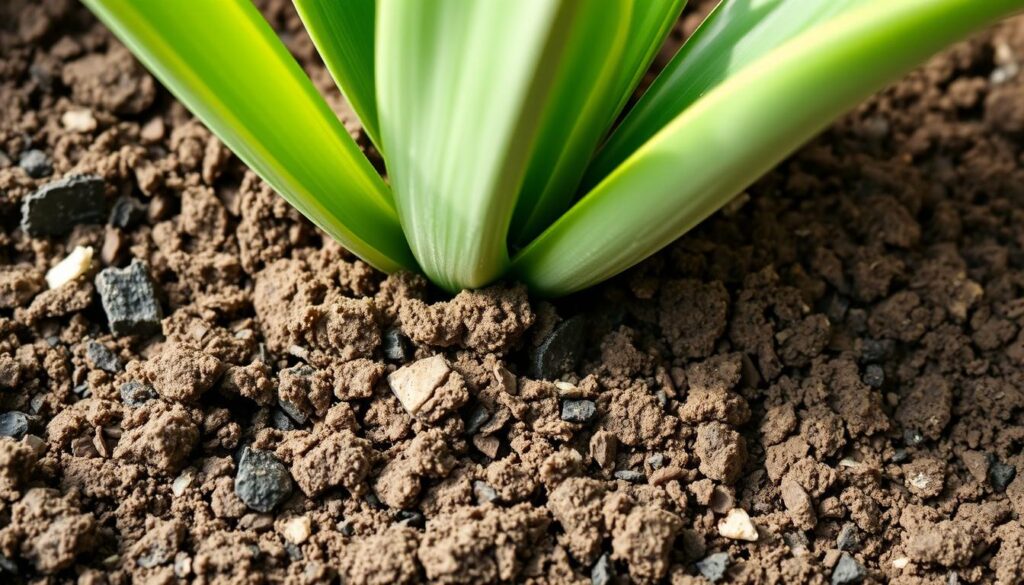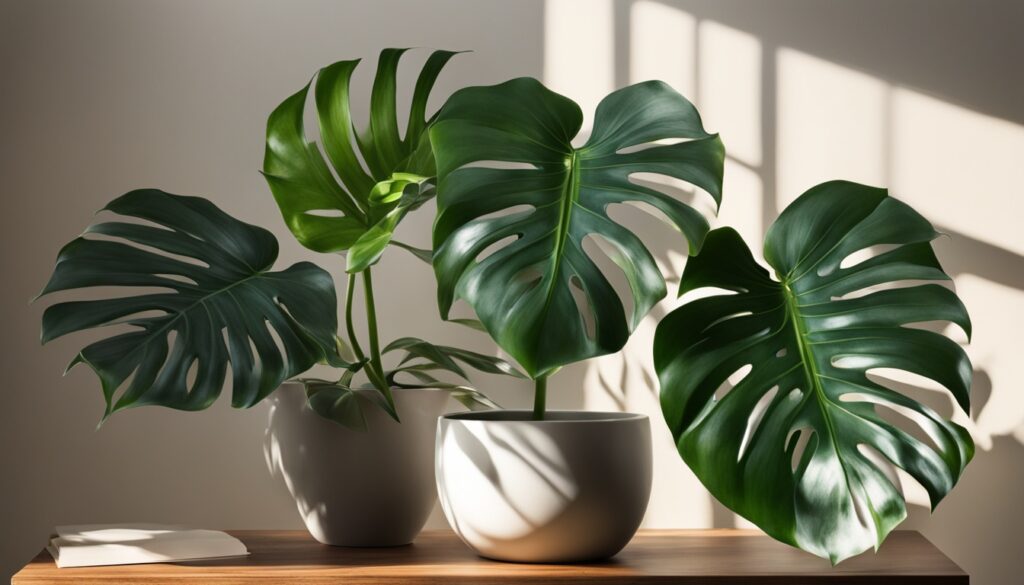Do you know the secret to keeping your snake plants (Sansevieria) thriving? It all starts with the right potting soil. These low-maintenance houseplants have specific soil requirements to ensure they stay healthy and happy. But what is the best potting soil for snake plants? Let’s explore the top options and uncover the ideal soil mix for your Sansevieria.
Key Takeaways
- Snake plants thrive in well-draining, aerated soil mixes that mimic their natural habitat
- Commercial options like FoxFarm Ocean Forest and Miracle-Gro Indoor Potting Mix are suitable for snake plants
- DIY soil mixes with potting soil, succulent/cactus mix, and organic amendments can be custom-tailored for snake plants
- Proper drainage and moisture control are crucial to prevent issues like root rot
- Snake plants are adaptable and can tolerate a range of soil conditions, but the right mix will keep them at their best
Understanding Snake Plant Soil Requirements
Snake plants, also known as Sansevieria, are tough and easy to care for. They do well in many soils. But, to keep them healthy, it’s key to know what they need in terms of soil.
Natural Habitat and Soil Preferences
Snake plants come from Africa and Asia’s tropical areas. They grow in sandy or rocky soils that drain well. In their natural home, they learn to live with little water, just like they need in a well-draining potting mix.
Importance of Well-draining Soil
For snake plants, having a well-draining soil is very important. They can get root rot if their roots stay wet too long. Good soil lets air and water move freely, keeping the plant healthy.
Optimal pH Levels for Growth
The best pH for snake plants is between 5.5 and 7.0. This is slightly acidic to neutral. It helps them absorb nutrients well and grow strong. Keeping the right pH is vital for their health.
“Snake plants are almost indestructible indoor plants that can thrive in a wide range of soil conditions, but providing them with the right well-draining potting mix is crucial for their long-term health and growth.”
Components of an Ideal Snake Plant Soil Mix
Creating the perfect soil mix for your snake plant is key. The ideal snake plant potting soil recipe includes potting soil, succulent mix, organic compost, and worm compost. A mix of 2/3 potting soil and 1/3 succulent mix is best. It gives your snake plant the nutrients, air, and water it needs to grow well.
To make the soil even better, add perlite, pumice, or clay pebbles. These potting soil ingredients for snake plants help with drainage and prevent waterlogging. Together, they create the perfect environment for your snake plant to flourish.
| Soil Component | Purpose | Recommended Ratio |
|---|---|---|
| Potting Soil | Provides essential nutrients | 2/3 |
| Succulent and Cactus Mix | Enhances drainage and aeration | 1/3 |
| Organic Compost | Improves soil structure and moisture retention | Optional |
| Worm Compost | Adds beneficial microorganisms and nutrients | Optional |
| Perlite, Pumice, or Clay Pebbles | Enhances drainage and aeration | Optional |
By using these snake plant potting soil recipe components, you can make a balanced, nutrient-rich, and draining soil mix. This mix will help your snake plant grow strong and healthy.
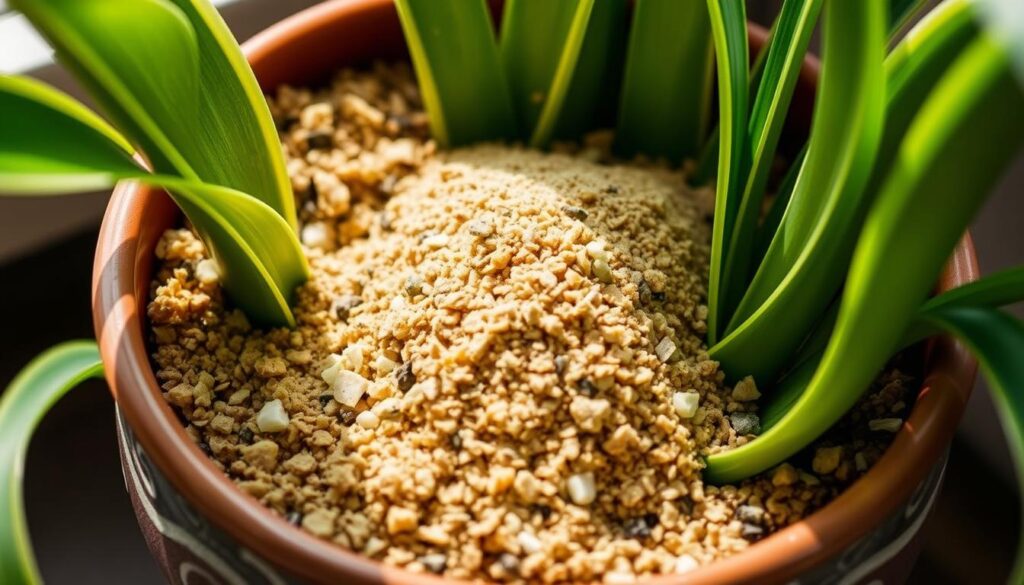
“The right soil mix is the foundation for a thriving snake plant. It’s essential to get the balance of nutrients, drainage, and aeration just right.”
Best Potting Soil for Snake Plant: Popular Commercial Options
Several commercial mixes are great for snake plants. These pre-formulated potting mixes offer the right balance of nutrients and drainage. They also ensure good aeration for these hardy plants.
FoxFarm Ocean Forest Organic Potting Soil
FoxFarm Ocean Forest Organic Potting Soil is a top pick for snake plants. It has a pH of 6.3-6.5, perfect for these plants. It’s made from organic materials like earthworm castings and bat guano. This mix supports strong growth and bright leaves.
Miracle-Gro Indoor Potting Mix
Miracle-Gro Indoor Potting Mix is another great choice. It’s made for indoor plants and has a mild fertilizer. It also helps fight fungus gnats, a common problem for snake plants.
Espoma Organic Potting Mix
Espoma Organic Potting Mix is also excellent for snake plants. It includes Myco-tone, which helps with moisture and nutrient absorption. This makes it a great match for snake plants’ needs.
These commercial soils offer the right mix of nutrients and aeration. They’re perfect for growing healthy and vibrant Sansevieria plants.
| Potting Soil | Key Features | Ideal for Snake Plants |
|---|---|---|
| FoxFarm Ocean Forest Organic Potting Soil | pH range of 6.3-6.5, made from organic ingredients | ✓ |
| Miracle-Gro Indoor Potting Mix | Includes a mild fertilizer, designed to reduce fungus gnats | ✓ |
| Espoma Organic Potting Mix | Contains Myco-tone for improved moisture retention | ✓ |
“These commercial soil mixes can sometimes retain too much water, leading to issues with snake plant growth.”
Essential Soil Amendments and Additives
To grow a healthy snake plant, you need more than just the right potting soil. Adding special soil amendments and additives can make the soil better for these plants. Knowing what snake plants need helps gardeners make the best soil for them.
Perlite is a key soil amendment for snake plants. It helps with drainage and air, stopping water from pooling and helping roots grow well. Pumice and clay pebbles also improve soil structure and air flow.
Adding organic matter like worm castings and bat guano enriches the soil. These natural fertilizers give plants the nutrients they need and keep the soil healthy.
Coconut coir is another great additive. It helps keep the soil moist but also drains well. This makes a balanced soil mix that snake plants love.
| Soil Amendment | Benefit |
|---|---|
| Perlite | Improves drainage and aeration |
| Pumice | Enhances soil structure and air circulation |
| Worm Castings | Provides essential nutrients |
| Bat Guano | Enriches the soil with nutrients |
| Coconut Coir | Improves moisture retention and drainage |
Using these snake plant soil amendments and potting soil additives helps gardeners make the best soil for their plants. With the right mix, snake plants can grow well and add beauty to any room.
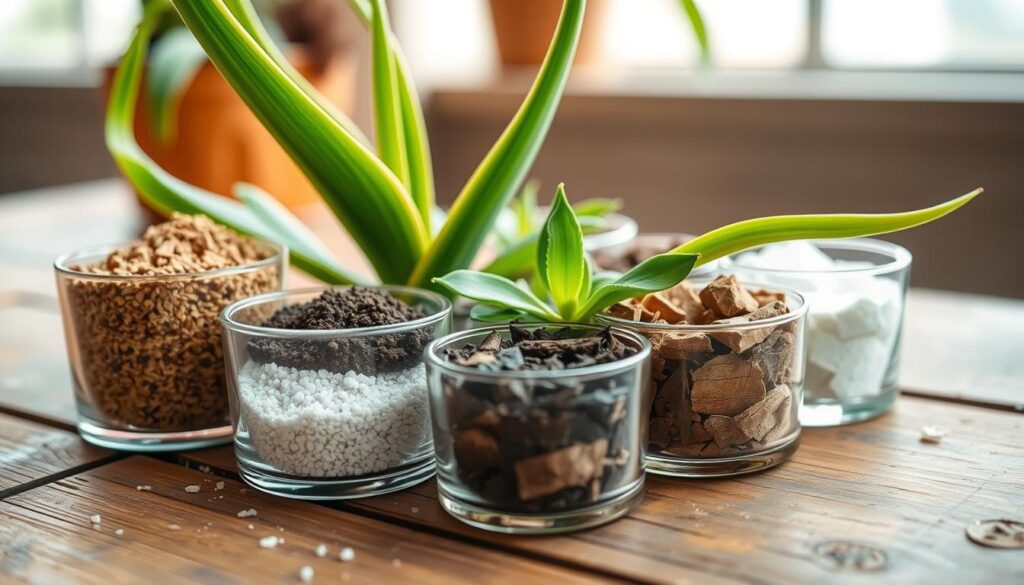
“The key to a thriving snake plant is a well-designed soil mix that promotes excellent drainage and aeration while providing essential nutrients.”
Creating Your DIY Snake Plant Soil Mix
Making your own snake plant soil mix is rewarding and saves money. Snake plants love soil that drains well and is rich in nutrients. By mixing the right ingredients, you can make a soil blend that meets your snake plant’s needs.
Base Components
The key to a good DIY snake plant soil mix is its base ingredients:
- Potting soil: Choose a high-quality mix that drains well and is free of harmful chemicals.
- Succulent and cactus mix: This mix is great for snake plants because it drains well and aeration is good.
- Organic compost: Adding compost makes the soil more fertile and holds moisture better.
Optional Additives
Adding these optional ingredients can make your soil mix even better:
- Perlite: It makes the soil airier and helps water drain faster.
- Pumice: Like perlite, it improves soil structure and water retention.
- Worm castings: These are packed with nutrients and act as a slow-release fertilizer.
Mixing Ratios and Proportions
The best mix for a DIY snake plant soil is 2/3 potting soil to 1/3 succulent and cactus. Add a handful of organic compost. This mix drains well, holds nutrients, and retains water for your snake plant’s growth.
By making your own snake plant soil mix, you give your Sansevieria the best growing medium. It will stay lush and vibrant for years. Try different mixes and additives to find what works best for your snake plant and your gardening style.
Role of Drainage in Snake Plant Soil
Proper drainage is key for your snake plant’s health. Well-draining soil stops water from staying too long, which can cause root rot.
For good drainage, pick a pot with holes at the bottom. Adding gravel or small rocks at the pot’s base helps water flow and keeps soil loose.
- Use a potting mix with well-draining stuff like perlite or pumice. These help the soil breathe and drain better, avoiding waterlogging.
- Stay away from heavy, moist soils. They can choke the roots and cause many problems.
- Make sure the new pot has enough holes when you repot or transplant. This stops water from building up.
Give your snake plant a well-draining potting mix and good drainage. This creates a perfect spot for its roots to grow and keeps it healthy. It also stops problems linked to importance of drainage for snake plants.
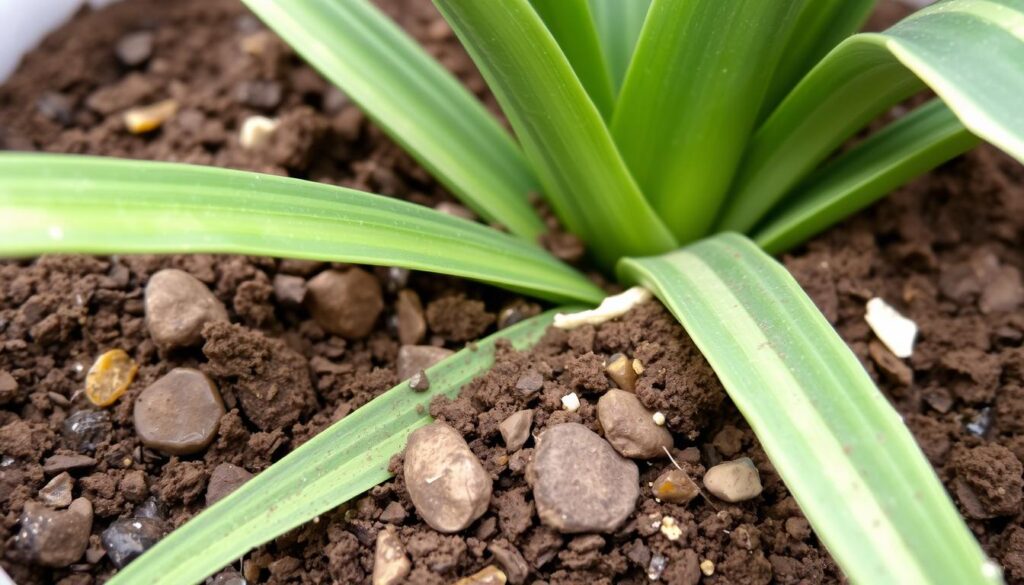
“Overwatering is the number one killer of snake plants. Ensuring proper drainage is the key to keeping these plants healthy and happy.”
Organic vs. Synthetic Soil Options
Choosing the right potting soil for your snake plants is key. You can pick between organic and synthetic mixes. Each has its own benefits, depending on what your snake plant needs and your gardening style.
Benefits of Organic Mixes
Organic potting soil is made from natural stuff like compost, peat moss, and bark. It slowly releases nutrients, feeding your snake plant steadily. Organic mixes also make the soil for your plant’s roots by improving drainage and aeration.
Synthetic Mix Advantages
Synthetic soil lets you control the nutrients more precisely. It’s made with the right amounts of nitrogen, phosphorus, and potassium for snake plants. This mix ensures your plant gets the nutrients it needs consistently.
Both organic and synthetic soils can help your snake plant thrive. The right choice depends on your gardening style and what your plant needs.
Soil Moisture Retention Properties
Finding the right soil moisture balance is key for snake plants. They do well in soil that holds some moisture but doesn’t get too wet. Snake plants thrive in well-draining soil that lets the top 2-3 inches dry out between waterings.
Coconut coir and sphagnum peat moss help keep the soil moist. They prevent too much or too little water. The best soil for snake plants holds enough moisture to feed the plant but also drains well to avoid root rot.
Knowing what snake plants like in their soil helps you make a good potting mix. This mix keeps them healthy and upright. Good moisture retention is key for their lush, vertical growth.
| Soil Component | Function | Recommended Percentage |
|---|---|---|
| Coconut Coir | Moisture Retention | Up to 30% |
| Sphagnum Peat Moss | Moisture Retention | Up to 30% |
| Perlite | Aeration and Drainage | Up to 40% |
| Sand | Drainage | Up to 15% |
By mixing materials like coconut coir and peat moss with perlite and sand, you get the perfect soil. This mix meets the snake plant soil moisture retention needs.
“Proper soil moisture retention is essential for the health and growth of snake plants. Finding the right balance between moisture and drainage can make all the difference in keeping these plants thriving.”
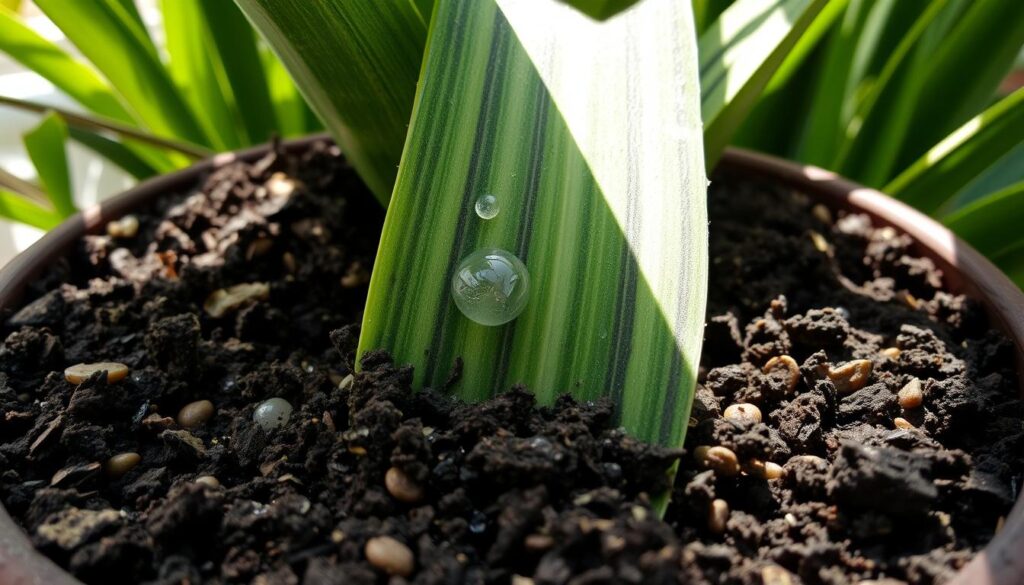
Nutrient Content and Fertilization Needs
Snake plants, also known as Sansevieria, need specific nutrients to grow well. They prefer a nutrient-rich soil blend for snake plant with a balanced NPK ratio, like 10-10-10. They also need micronutrients like boron, manganese, zinc, and copper for health.
For fertilization requirements for snake plants, a little goes a long way. Feed them twice a year, in spring and summer. Organic compost and worm castings are great for natural nutrients, helping them grow without overfeeding.
Too much fertilizer can harm snake plants, causing yellow leaves or stunted growth. It’s important to follow the right guidelines. Adjust how often you feed based on the light they get. Plants in bright light need more food, while those in dimmer spots can get by with less.
| Lighting Conditions | Fertilization Frequency |
|---|---|
| High Light | Every 3 months |
| Medium Light | Twice a year |
| Low Light | Once a year |
By finding the perfect balance in nutrient-rich soil blend for snake plant and fertilization requirements for snake plants, you can help your snake plants flourish. They will show off their vibrant leaves and, under the right conditions, even bloom beautifully.
Signs Your Snake Plant Needs Soil Replacement
Snake plants can grow too big for their soil, needing a refresh. Knowing when and how to repot keeps your Cylindrical Snake Plant (Sansevieria trifasciata) healthy and bright.
Visual Indicators
Several signs show your snake plant needs new soil. Look for slow growth, yellow leaves, and poor drainage. If roots are showing through holes or the plant is lifting, it’s time to repot.
Timing Considerations
Snake plants usually need a new pot every 4-6 years, best in spring or early summer. If it’s growing fast, you might need to repot every 2-3 years. When repotting, pick a pot 2 inches wider to support growth.
Good soil and repotting are key for your snake plant’s health. Knowing when to act helps your plant thrive for many years.
| Signs of Poor Soil for Snake Plants | Optimal Repotting Frequency |
|---|---|
| – Slow growth – Yellowing leaves – Soil that doesn’t drain well – Roots pushing through drainage holes – Plant lifting itself out of the soil – Pot cracking due to root pressure – Foliage filling the pot completely |
– Every 4-6 years for average growth – Every 2-3 years for rapid growth – During the growing season (spring/early summer) – Choose a pot 2 inches wider than the current one |
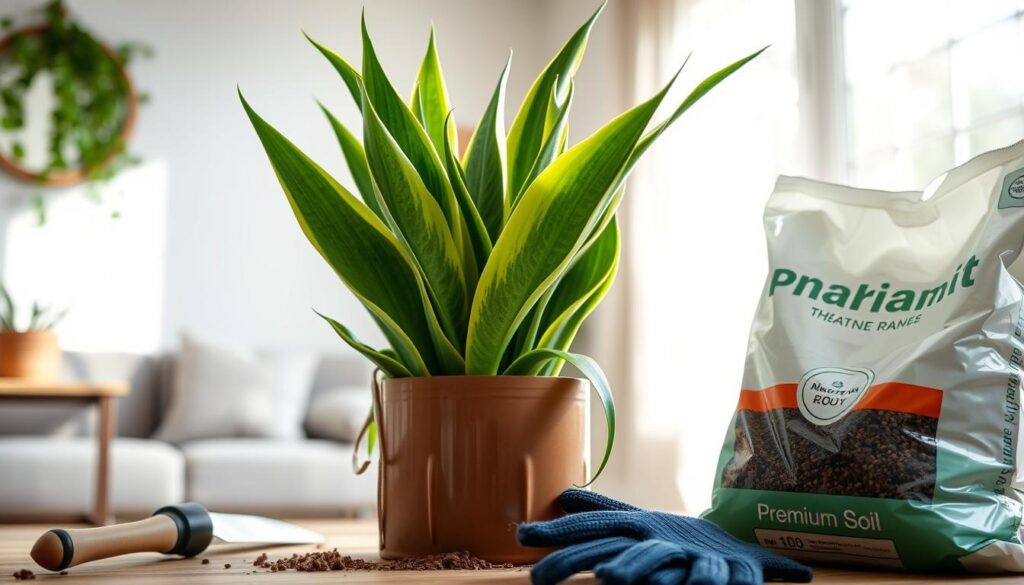
“Proper soil preparation and repotting techniques are crucial for the long-term health of your snake plant.”
Avoiding Common Soil-Related Problems
Keeping the right soil conditions is key for snake plants to stay healthy. Issues like overwatering, poor drainage, and not enough nutrients are common. Knowing how to fix these problems helps your snake plants grow well.
Overwatering is a big problem. It can cause root rot and other issues. To avoid this, use soil that drains well and pots with holes. This lets water out, keeping the roots healthy.
- Don’t water too much. Let the soil dry out between waterings.
- Make sure your snake plant’s pot has enough holes for water to drain.
- Choose a well-draining soil mix, like a mix of potting soil and cactus/succulent blend.
Nutrient shortages can also harm snake plants. They might grow slowly or have yellow leaves. Regular soil checks and the right fertilizer help keep plants healthy.
- Watch for signs of nutrient lack, like yellow leaves or slow growth.
- Use a balanced, slow-release fertilizer during the growing season.
- Don’t over-fertilize, as it can cause problems too.
By fixing these common soil issues and keeping the soil healthy, your snake plants will do great. They’ll be a wonderful, easy-to-care-for part of your home.
Seasonal Soil Maintenance Tips
Keeping your snake plant’s soil healthy is key to its success. You need to change how you care for the soil with the seasons. This matches the plant’s growth patterns all year.
In winter, snake plants rest. So, water them less and skip fertilizing. This saves energy and prevents problems like root rot.
Spring is the best time to repot your snake plant. Repotting then helps it grow strong roots. It also gives it the nutrients it needs to do well.
Summer is when your snake plant grows most. So, watch the soil moisture closely. Make sure it’s not too dry or too wet.
- Aerate the soil often to keep oxygen flowing and prevent it from getting too dense.
- Add a thin layer of fresh compost or organic matter on top of the soil. This adds nutrients.
By following these tips, you’ll help your snake plant grow well all year. It will thank you with beautiful leaves and a strong presence.
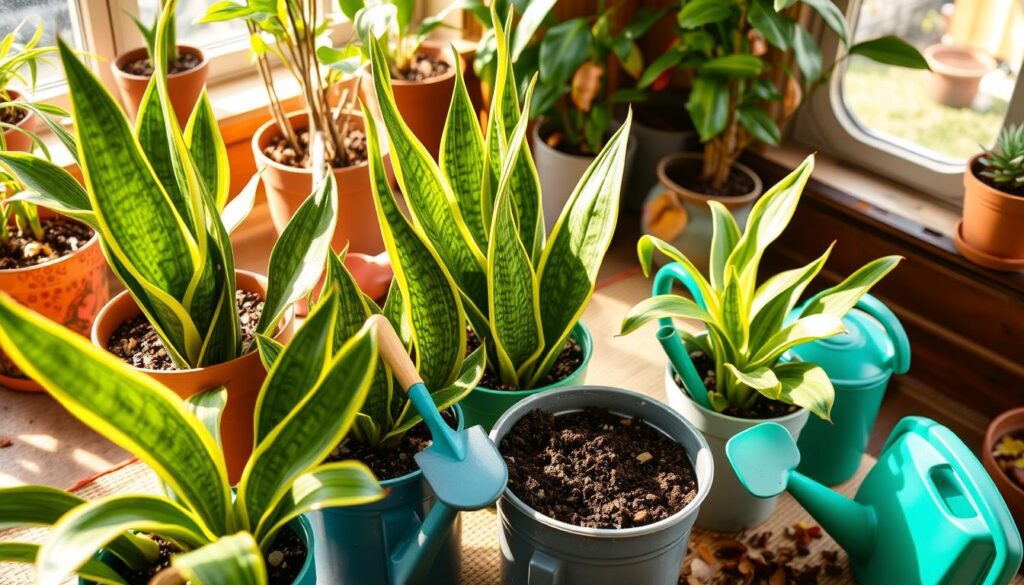
“Consistent, proper soil care is the foundation for a healthy, thriving snake plant.”
Container Selection and Soil Volume
Choosing the right snake plant container is key for its growth and health. Pick a pot that’s 1-2 inches larger than the current one. This size helps the plant feel slightly root-bound.
Pot Size Guidelines
The pot size should match your snake plant’s growth potential. Small plants do well in shallow pots, while tall ones need deeper containers. Avoid overpotting to prevent water and nutrient problems.
Drainage Requirements
Good drainage is crucial for snake plants. Make sure the pot has enough holes to prevent water from pooling. Plastic pots are better than terracotta because snake plant roots can crack terracotta. Fill the pot with best potting soil for snake plants up to an inch from the top.
| Pot Material | Advantages | Disadvantages |
|---|---|---|
| Terracotta | Breathable, helps prevent overwatering | Prone to cracking, can be heavy |
| Plastic | Lightweight, retains moisture longer | Can inhibit air flow to roots |
| Ceramic | Aesthetically pleasing, balanced moisture retention | Can be heavy, requires proper drainage |
When picking a snake plant container, think about both looks and function. Choose a pot that offers good drainage and root space. It should also match your plant’s beauty and your style.
Professional Growing Tips and Tricks
We’re excited to share our top tips for growing snake plants. These plants are easy to care for but still look amazing. Whether you’re new to growing plants or have experience, our advice will help you get the most out of your snake plants.
One key piece of advice is to use a soil moisture meter. Overwatering is a big problem that can harm your plant. Also, adding a layer of activated charcoal at the bottom of the pot helps with drainage and keeps odors away.
- Propagate snake plants through leaf cuttings in the spring, using soil that drains well to help them grow.
- Rotate your snake plant’s pot regularly to ensure even growth and prevent leaves from becoming uneven.
- Use distilled or rainwater instead of tap water to avoid mineral buildup in the soil.
By following these tips, you can grow healthy, vibrant snake plants that brighten up your space.
“The snake plant is a true testament to resilience and low-maintenance care. With the right techniques, anyone can cultivate these stunning houseplants and enjoy their air-purifying benefits for years to come.”
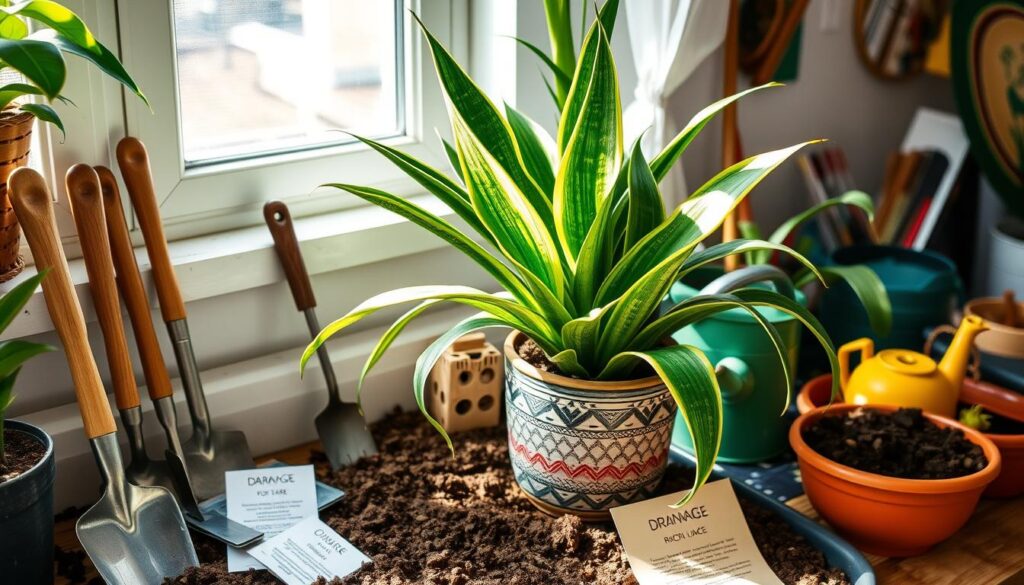
The secret to growing great snake plants is finding the right balance. Water them right, use good soil, and keep the environment just right. With these tips, you’ll become a pro at growing snake plants and can create beautiful displays at home or in the office.
Conclusion
Choosing the right potting soil is key for snake plants’ health and growth. A mix that drains well, combining potting soil and succulent/cactus soil, is best. It lets water flow and prevents root rot.
Regular care, like watering and repotting, is vital for snake plant health. These steps help keep your plant strong and beautiful for years.
By picking the right soil and following care tips, snake plants can be great houseplants. They need a mix that drains and aerates well. This helps them grow strong.
Whether you buy a mix or make your own, aim for a soil that supports your snake plant’s growth. This article’s advice will help your plant thrive. It will be a beautiful part of your indoor plants.
